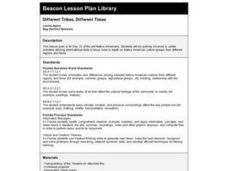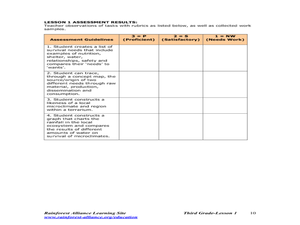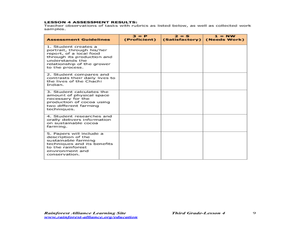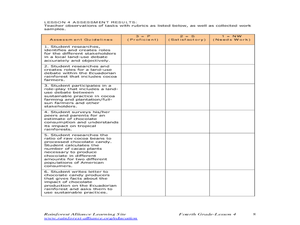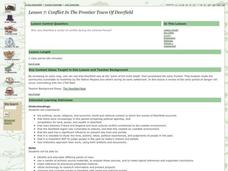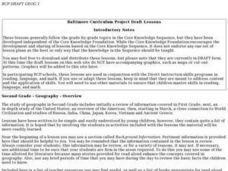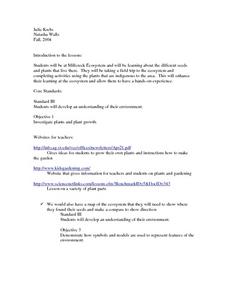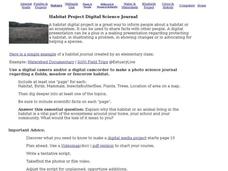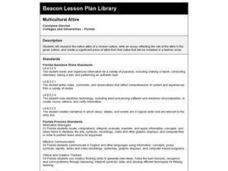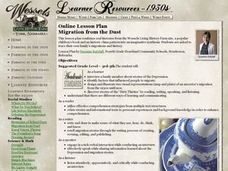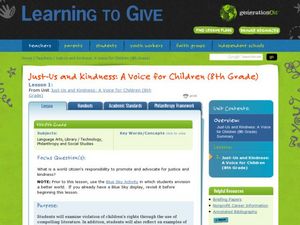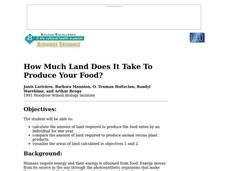Curated OER
Different Tribes, Different Times
Second graders study the different types of Native American culture groups. They, in groups, visit four different work stations to examine various culture groups and complete a Corn Cycle worksheet.
Curated OER
Inside The Harlem Renaissance
Students explore the Harlem Renaissance to discover where, when, and why it took place and who was associated with the experience. They decide what are the most informative facts, interesting people, and events in this lesson.
Curated OER
Louisiana Regional Foodways
Students strengthen their research techniques in locating, selecting, and synthesizing information from a variety of texts, media, references and internet resources to study regional food way traditions in Louisiana. They assess the...
Curated OER
Second Class Rank: merit badge
In this second class rank instructional activity, students fill out short answer questions using their workbook about compasses, safety, protection, swimming, and more in order to get a merit badge. Students complete 13 questions total.
Curated OER
A Powerpoint Presentation On Sustainability
Students are introduced to the important geography concept of sustainability by looking at the Roseau River floods of 2002. They discuss the impact of humans on the environment. They explain how sustainability relates to everyday geography.
Curated OER
Story Stretching: Tall Tales in North America
Students are introduced to tall tales. In this introductory tall tales unit, students explore the tall tales of Casey Jones and Johnny Appleseed. This unit includes many interdisciplinary lessons including graphing skills and geography.
Curated OER
What Is a Watershed?
Students explore the concept of water pollution. For this environmental stewardship lesson, students discover what watersheds are and consider how to protect them.
Curated OER
Third Grade Ecuadorian Rainforest
Third graders explore the Ecuadorian Rainforest. In this writing and research instructional activity students utilize several information sources to learn about the Ecuadorian Rainforest. Students also summarize and paraphrase...
Curated OER
Equadorian Rainforest: The Tropical Supermarket
Young scholars study the concept of sustainable agricultural practices through cocoa farming and the lives of the people who are the producers. Students watch a slide show and read a story which helps them understand the origins of...
Curated OER
How can we keep our forests intact and have chocolate too?
Fourth graders recognize the need to sustain crops in the rainforest. In this rainforest instructional activity, 4th graders consider the use of products from the rainforest. Students discuss how people of different points of...
Curated OER
Conflict in the Frontier town of Deerfield
Students use primary sources to investigate, explore and represent varying perspectives on the 1704 Deerfield Raid. They consider the reasons Deerfield was at the center of English, French and Native American conflicts in the early 18th...
Curated OER
Geography Lesson 1
Middle schoolers examine relationship between population centers and sports teams, explore influence of weather on attendance, and research influence of geography, traffic flow and disposable income on site selection for sports stadiums.
Curated OER
Ecosystem Field Trip
Students investigate the different seeds and plants that are part of the Millcreek ecosystem. They take a field trip to the ecosystem and complete activities using the plants that are indigenous to the area.
Curated OER
Habitat Project Digital Science Journal
In this habitat project digital science journal worksheet, students use a digital camera or camcorder to create a science journal about a habitat they have studied. This page includes links to helpful web resources for planning and...
Curated OER
A Healthy Heart is a Happy Heart
Students demonstrate their perception of what it means to have a healthy heart. They comprehend what each individual needs to do in order to ensure health and how to prevent heart disease.
Curated OER
Multicultural Attire
Young scholars research the native attire of a chosen culture, write an essay reflecting the role of the attire in the given culture, and create a significant piece of attire from that culture that be modeled in a fashion show.
Curated OER
Migration from the Dust
Students trace their own family's migrations and history. They listen to the story, 'Blue ow.' They design a plate which is shared at an open house.
Curated OER
Building Bridges for Young Learners--Culture
Students explore the concept of "culture." For this cross curriculum literacy and world history lesson, students listen to a letter written by a child from Namibia, then compare and contrast life in Africa with their own life. Students...
Curated OER
Exploring for Petroleum - Modeling an Oil Reserve
Young scholars experiment with locating oil reserves. In this conservation lesson, students use a cardboard box to create sand, rocks, and an oil reserve (water balloon). They use a probe to dig around in the box to find the oil reserve...
Curated OER
Mammals of Fields, Meadows, and Hedgerows
For this mammals worksheet, students research the internet to find information and answer short answer questions about mammals of fields, meadows, and hedgerows. Students complete 12 questions.
Curated OER
Treaties
Sixth graders research treaties. In this treaties lesson, 6th graders go online to build knowledge about treaties. Students read information and take quizzes. Students write a comparative essay about how the Aboriginal and...
Curated OER
The Great MPA Debate
Students study the 'Marine Protected Areas' process. In this ocean lesson students work in groups, conduct research and present it to the class.
Curated OER
Just-Us and Kindness: A Voice for Children: King Day
Eighth graders investigate philanthropy. In this service learning lesson plan, 8th graders read human rights literature and use information gleaned to discuss children's rights around the world. Students discuss scenarios meant to prompt...
Curated OER
How Much Land Does It Take To Produce Your Food?
Young scholars calculate the amount of land required to produce the food eaten by an individual for one year and compare the amount of land required to produce animal versus plant products. They use calorie counting resources to compile...
